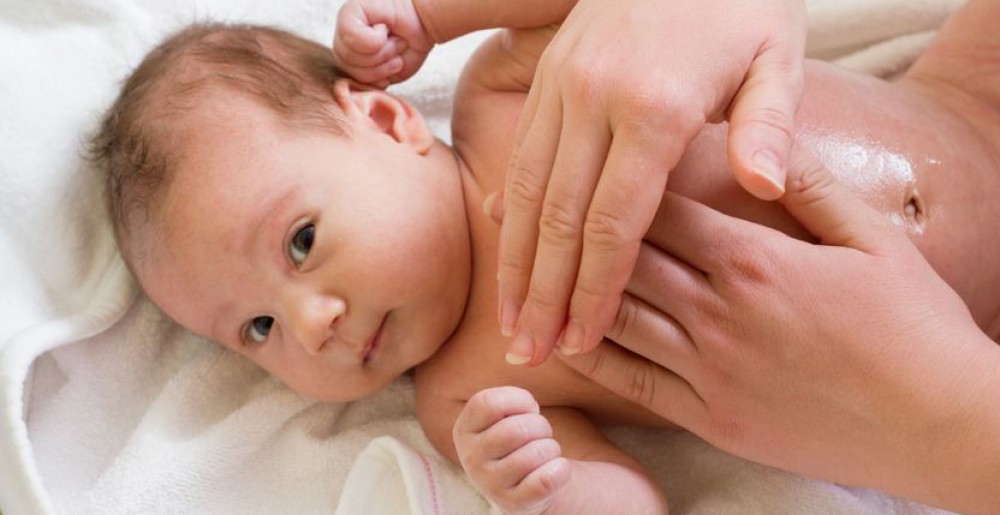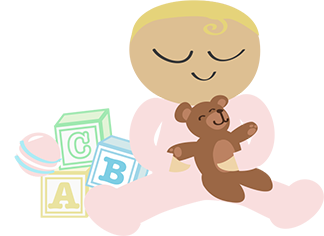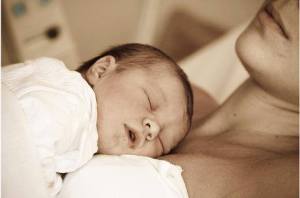When I had my babies in 1976 and 1978, we all slept on a king-size mattress on the floor. It seemed natural to me; I had travelled to India and knew that co-sleeping was ordinary for an entire family. If my baby woke, breastfed, and then fussed or cried, my husband got up, strapped him/her to his chest and fell asleep that way on a giant bean-bag chair we had in the living room. That way, neither one of us was sleep-deprived, and our babies didn’t ever cry-it-out.
Today, parents are warned over and over again that they should not sleep with their infants. Thankfully, some experts have come forth recanting that message and offering parents useful advice about HOW to sleep with their babies.
From BellyBelly.com.au – Australia’s Website for All Things Baby:
Babies and sleep: it can seem that the two are mutually exclusive. Recent research has suggested that many mothers who have been diagnosed as having post-natal depression are actually suffering extreme fatigue from waking to their babies at night.
This has puzzled me, knowing that almost all babies waken to feed during the night, and especially breastfed babies, because breastmilk is so easily and quickly digested. I have read research documenting the many times that mothers in other cultures feed their babies at night, apparently without distress or depression.
Night waking had been an issue for me with my first baby, and I had felt rather “sleep-deprived” in the early months. By the time my second was born, I had learned – mostly from experienced mothers – that most babies wake up, and I felt more relaxed about it.
I discovered that we all slept better in bed together, and that I felt less fatigued, even though Zoe breastfed 3 or 4 times nightly. I would wake as she stirred, and feed her before she cried; this saved my husband from being disturbed, and he was more available for the early morning shift.
Co-sleeping, or bed-sharing, also synchronized our cycles of deep and light sleep, so I was already in light sleep when Zoe awoke, and I didn’t have that panicked feeling at being woken from deep sleep. Even better, I didn’t have to get out of bed, and I often fell asleep after a few minutes with Zoe still on the breast.
My experiences are confirmed by the elegant research done by James McKenna, Professor of Anthropology at University of Notre Dame, Indiana, US and his colleagues, who invited 35 mother-baby pairs into a sleep research laboratory, and monitored overnight their sleep patterns as they slept together or in separate rooms. They found that, not only did co-sleeping pairs get into the same sleep cycles, but that babies who co-slept experienced more frequent “arousals”, triggered by the mother’s movements, and spent less time in deep sleep.
As a researcher in SIDS, Professor McKenna believes that these low-level arousals, which did not actually awaken either partner, give the baby practice in arousing itself. This may lessen a baby’s susceptibility to some forms of SIDS which are thought to be caused by failure to arouse from deep sleep to re-establish breathing patterns.
Professor McKenna speculates that millions of years of co-sleeping and night feeding have not developmentally prepared young babies to “sleep through” in a solitary bed, involving, as this does, long periods of deep sleep.
There are many other benefits of co-sleeping, such as keeping the baby warm, increased access to the breast (which ensures a good supply), less crying, and the practical observation that co-sleeping babies almost always sleep on their backs, which is a significant factor in reducing SIDS risk.
Videos taken during the study showed that co-sleeping mothers, even in deep sleep, seemed aware of their baby’s position, and moved when necessary to avoid over-laying. At no time in the study did co-sleeping mothers impede the breathing of their babies, who actually had higher average oxygen levels than solitary sleepers.
Although there is no direct evidence to prove Professor McKenna’s theories, some of the lowest rates of SIDS are found amongst cultures where co-sleeping is predominant.
Western studies indicate that co-sleeping does not increase SIDS risk unless co-sleeping parents smoke or use alcohol or drugs. Co-sleeping parents must ensure that their baby’s head does not become covered by bedding, that the baby cannot sink into an overly soft mattress (water beds are not recommended) and that the baby does not become entrapped or overheated.
Fathers, non-breastfeeding mothers and working parents may particularly appreciate the cosy intimacy that sleeping with a baby brings. I do not see co-sleeping as a panacea for fatigue, but for many families, it is easier, more pleasurable and less tiring than our cultures usual sleeping arrangements.
Safe Co-Sleeping Facts
(Pinky McKay)
‘Co-sleeping’ defines a range of sleeping styles – from sleeping with your baby all night, to taking your little one into your bed for an early morning breastfeed and snuggling together for a few extra zzzs. For some families, co-sleeping can mean embracing not only the baby, but a whole new concept in bedroom decor with baby’s cot butted against the parents bed and the nearest side down for easy access to comfort baby. This option may be preferable if one partner is extremely tired or anxious about bed-sharing. However, if you do this, make sure that neither the cot, nor your bed can roll and there are no gaps between the cot and your bed.
The bottom line is that many parents share sleep with their babies – according to a recent study at Durham University, 63 percent of parents often take their babies into bed with them. So, rather than ask, “is it safe to sleep with my baby?” we should be asking, “how can I sleep with my baby safely?”
Whatever your sleeping arrangements, it is important to provide a safe sleeping environment for your baby. If you choose to sleep with your baby, both parents should feel comfortable with the decision and accept equal responsibility for baby’s safety:
Do not sleep with your baby if you are under the influence of any substance such as alcohol or medication/drugs (prescription or otherwise i.e. antihistamines) that could induce a deeper sleep and reduce awareness of your baby (either partner).
Do not co-sleep if you are a smoker (either partner). The risk of SIDS is increased if the mother smokes during pregnancy or after the birth. There is also some evidence to suggest that a father smoking during his partner’s pregnancy increases the risk, and if both parents smoke the risk is doubled. In fact, it’s preferable not to let anyone smoke near your baby.
Sleep on a firm, flat surface (not a waterbed) and ensure the mattress tightly intersects the bed frame.
Don’t co-sleep on a couch or sofa, as babies can easily slip down into the crevice or face-first between cushions, or they may become wedged between the adult and the back of the couch.
Avoid overheating by keeping baby’s head uncovered and do not use doonas or electric blankets whilst co-sleeping. Baby will be kept warm by your own body heat, so avoid over dressing or over bundling baby – enjoy the delicious skin contact.
If you have long hair, tie it back, and consider that very large breasts or extreme obesity may reduce awareness of your baby’s position.
Avoid pungent hair sprays, deodorants, and perfumes. Not only will these camouflage the natural maternal smells that baby is used to and attracted to, but foreign odors may irritate and clog baby’s tiny nasal passages.
Cut off ties from your own nightwear that may pose a strangulation hazard to baby.
At first it is wise to position baby next to mother, rather than between mother and father, as fathers tend to sleep more deeply and may be less aware of the baby.
Take precautions to prevent baby from rolling out of bed, even though it is unlikely when baby is sleeping next to mother. According to pediatrician William Sears, ‘like heat-seeking missiles, babies automatically gravitate toward a warm body.’ Perhaps place the bed firmly against the wall, and fill cracks or empty spaces with a rolled up blanket, or use a guard-rail – mesh guard rails are safer than slatted ones.
To prevent baby becoming ‘stuck’ between the night table and bed if in the unlikely event that he does accidentally fall out of bed, make sure any furniture is pushed far away from the bed.
Don’t allow older siblings to sleep with a baby under nine months. Sleeping children do not have the same awareness of tiny babies as do parents, and too small or too crowded a bed space is an unsafe sleeping arrangement for a tiny baby.
Never leave a baby on an adult bed unattended




Pingback: BABIES AND SLEEP: THE BENEFITS OF CO-SLEEPING | Infants, Babies, the Power of Touch